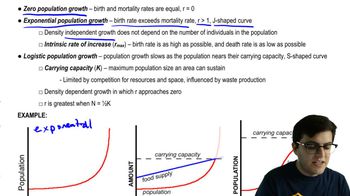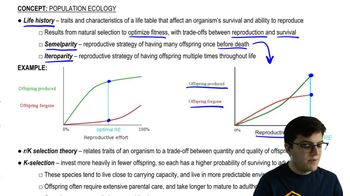Table of contents
- 1. Introduction to Biology2h 40m
- 2. Chemistry3h 40m
- 3. Water1h 26m
- 4. Biomolecules2h 23m
- 5. Cell Components2h 26m
- 6. The Membrane2h 31m
- 7. Energy and Metabolism2h 0m
- 8. Respiration2h 40m
- 9. Photosynthesis2h 49m
- 10. Cell Signaling59m
- 11. Cell Division2h 47m
- 12. Meiosis2h 0m
- 13. Mendelian Genetics4h 41m
- Introduction to Mendel's Experiments7m
- Genotype vs. Phenotype17m
- Punnett Squares13m
- Mendel's Experiments26m
- Mendel's Laws18m
- Monohybrid Crosses16m
- Test Crosses14m
- Dihybrid Crosses20m
- Punnett Square Probability26m
- Incomplete Dominance vs. Codominance20m
- Epistasis7m
- Non-Mendelian Genetics12m
- Pedigrees6m
- Autosomal Inheritance21m
- Sex-Linked Inheritance43m
- X-Inactivation9m
- 14. DNA Synthesis2h 27m
- 15. Gene Expression3h 20m
- 16. Regulation of Expression3h 31m
- Introduction to Regulation of Gene Expression13m
- Prokaryotic Gene Regulation via Operons27m
- The Lac Operon21m
- Glucose's Impact on Lac Operon25m
- The Trp Operon20m
- Review of the Lac Operon & Trp Operon11m
- Introduction to Eukaryotic Gene Regulation9m
- Eukaryotic Chromatin Modifications16m
- Eukaryotic Transcriptional Control22m
- Eukaryotic Post-Transcriptional Regulation28m
- Eukaryotic Post-Translational Regulation13m
- 17. Viruses37m
- 18. Biotechnology2h 58m
- 19. Genomics17m
- 20. Development1h 5m
- 21. Evolution3h 1m
- 22. Evolution of Populations3h 52m
- 23. Speciation1h 37m
- 24. History of Life on Earth2h 6m
- 25. Phylogeny2h 31m
- 26. Prokaryotes4h 59m
- 27. Protists1h 12m
- 28. Plants1h 22m
- 29. Fungi36m
- 30. Overview of Animals34m
- 31. Invertebrates1h 2m
- 32. Vertebrates50m
- 33. Plant Anatomy1h 3m
- 34. Vascular Plant Transport2m
- 35. Soil37m
- 36. Plant Reproduction47m
- 37. Plant Sensation and Response1h 9m
- 38. Animal Form and Function1h 19m
- 39. Digestive System10m
- 40. Circulatory System1h 57m
- 41. Immune System1h 12m
- 42. Osmoregulation and Excretion50m
- 43. Endocrine System4m
- 44. Animal Reproduction2m
- 45. Nervous System55m
- 46. Sensory Systems46m
- 47. Muscle Systems23m
- 48. Ecology3h 11m
- Introduction to Ecology20m
- Biogeography14m
- Earth's Climate Patterns50m
- Introduction to Terrestrial Biomes10m
- Terrestrial Biomes: Near Equator13m
- Terrestrial Biomes: Temperate Regions10m
- Terrestrial Biomes: Northern Regions15m
- Introduction to Aquatic Biomes27m
- Freshwater Aquatic Biomes14m
- Marine Aquatic Biomes13m
- 49. Animal Behavior28m
- 50. Population Ecology3h 41m
- Introduction to Population Ecology28m
- Population Sampling Methods23m
- Life History12m
- Population Demography17m
- Factors Limiting Population Growth14m
- Introduction to Population Growth Models22m
- Linear Population Growth6m
- Exponential Population Growth29m
- Logistic Population Growth32m
- r/K Selection10m
- The Human Population22m
- 51. Community Ecology2h 46m
- Introduction to Community Ecology2m
- Introduction to Community Interactions9m
- Community Interactions: Competition (-/-)38m
- Community Interactions: Exploitation (+/-)23m
- Community Interactions: Mutualism (+/+) & Commensalism (+/0)9m
- Community Structure35m
- Community Dynamics26m
- Geographic Impact on Communities21m
- 52. Ecosystems2h 36m
- 53. Conservation Biology24m
50. Population Ecology
Introduction to Population Ecology
Problem 8a
Textbook Question
Populations that rely on stored resources are likely to overshoot the carrying capacity of the environment and consequently experience a(n) . a. demographic momentum; b. cultural carrying capacity; c. decrease in death rates; d. population crash; e. exponential growth
 Verified step by step guidance
Verified step by step guidance1
Identify the key concept: Carrying capacity refers to the maximum number of individuals an environment can support sustainably. When a population overshoots this limit, it consumes resources faster than they can be replenished.
Understand the consequences of overshooting carrying capacity: When a population exceeds the carrying capacity, it initially may continue to grow due to the stored resources, but this is unsustainable in the long term.
Analyze the options given: Consider each option and how it relates to the concept of overshooting carrying capacity and its consequences.
Link the correct option to the scenario: A population crash typically occurs after a population overshoots its carrying capacity, due to the depletion of resources and subsequent inability to support the oversized population.
Eliminate other options: Options such as demographic momentum, cultural carrying capacity, decrease in death rates, and exponential growth do not directly describe the immediate consequence of overshooting carrying capacity, which is a sharp decline in population size, or a population crash.
Recommended similar problem, with video answer:
 Verified Solution
Verified SolutionThis video solution was recommended by our tutors as helpful for the problem above
Video duration:
2mPlay a video:
Was this helpful?
Key Concepts
Here are the essential concepts you must grasp in order to answer the question correctly.
Carrying Capacity
Carrying capacity refers to the maximum number of individuals of a species that an environment can sustainably support without degrading the habitat. It is influenced by factors such as resource availability, environmental conditions, and interactions with other species. When a population exceeds its carrying capacity, it can lead to resource depletion and negative impacts on the ecosystem.
Recommended video:
Guided course

Estimating Earth’s Human Carrying Capacity
Population Overshoot
Population overshoot occurs when a population temporarily exceeds the carrying capacity of its environment, often due to an abundance of resources or favorable conditions. This can lead to a rapid increase in population size, but it is typically followed by a decline as resources become scarce, resulting in increased competition and mortality rates.
Recommended video:
Guided course

The Human Population
Population Crash
A population crash is a dramatic decline in the size of a population, often following an overshoot of the carrying capacity. This decline can result from resource depletion, increased mortality, and decreased reproduction rates. Population crashes can have significant ecological consequences, affecting not only the species involved but also the broader ecosystem.
Recommended video:
Guided course

Population Density and Cycles

 1:17m
1:17mWatch next
Master Population Ecology with a bite sized video explanation from Jason Amores Sumpter
Start learningRelated Videos
Related Practice


































































